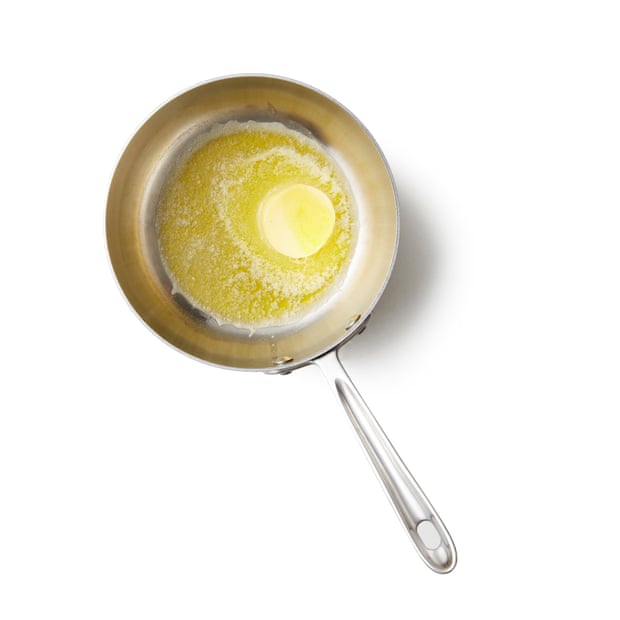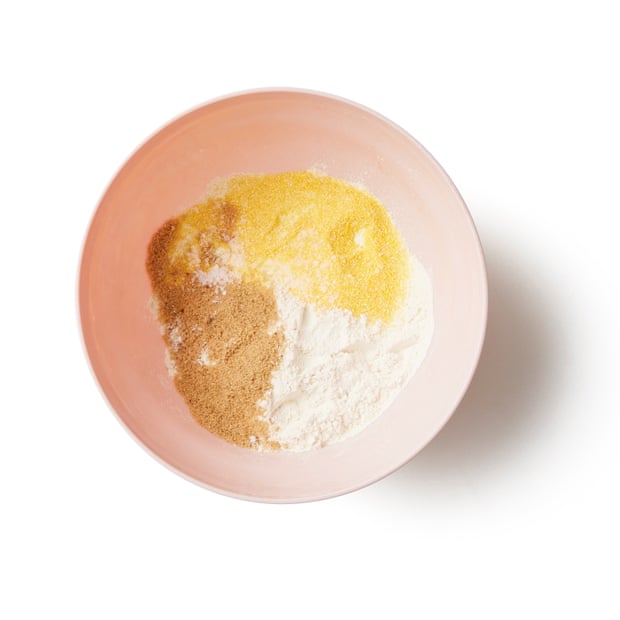An ancient festive food that still feels like a special occasion today, the Belgian waffle is all too often a mere spongy mattress for mountains of whipped cream and syrupy sauce, when it deserves to be the main attraction. It might not be Monday-morning fare, but at the weekends, or on holiday, a hot waffle is a tradition worth celebrating.
Prep 15 min
Rest 1 hr+
Cook 25 min
Makes 10
6 tbsp melted butter (about 60g)
180ml milk
1 tbsp (10g) active dried yeast
1 tbsp soft light brown sugar, or more to taste
245g flour
1 tbsp cornmeal or dry polenta, or 1 extra tbsp flour
½ tsp salt
240ml buttermilk
1 large egg, beaten
Oil, to grease
1 Make the batter well ahead
If you’re having these for breakfast, I’d advise making the batter the night before, unless you’re getting up early. You’ll also need a waffle iron, I’m afraid; there’s just no way around it, because, without one, this batter will just make pancakes (also delicious, but not waffles). You can buy electric ones, though I make mine on a simple stove-top model.
2 Add the yeast to warm milk
Melt the butter in a pan and set aside.


Warm the milk to roughly blood temperature, then stir in the yeast and a pinch of sugar, then leave to sit until the surface of the milk is covered in tiny bubbles (if this doesn’t happen, either your milk was too hot or the yeast is dead).
3 Mix the dry ingredients
Meanwhile, put the flour, cornmeal or polenta, if using, in a large bowl. (Polenta is optional, but will give the finished waffles some extra crunch; it’s often found in the speciality or world food aisles of larger supermarkets. Add another tablespoon of flour if you aren’t using it).

Add the salt and the rest of the sugar, and whisk to combine.
4 Mix the wet ingredients, then add to the dry
Beat the buttermilk, melted butter and egg in a jug (if you can’t find buttermilk, use 240ml extra milk with a tablespoon of lemon juice or white vinegar stirred in).

When the yeast is ready, whisk the milk mix into the same jug, then gently stir it all into the dry ingredients; don’t overmix or your waffles will be tough.

5 Cover and rest

Cover the bowl loosely with a tea towel or similar and leave to sit at room temperature for an hour or so, or overnight (this can either be at room temperature or in the fridge, if you prefer). I think the longer rise gives them an even better flavour, but they’ll still be good if cooked on the same day.
6 Grease the waffle iron
Turn the oven on low, to keep the cooked waffles warm later, unless you have an audience ready to eat them as fast as you can make them.
Lightly grease a waffle iron, then put it on a medium-high heat (or, if using an electric one, whatever setting the manufacturer recommends). Make sure the iron is hot before adding any batter.

7 Cook the first waffle
Pour in just enough batter to cover the base of the waffle plates, spreading it out with a spatula and bearing in mind that it will rise during cooking, then turn down the heat slightly and close the lid (again, if using an electric waffle maker, follow the manufacturer’s instructions). Cook for about 45-60 seconds, until golden on the underside.
8 Flip and cook on the other side
Flip the waffle iron, so the other side is now on the heat (you won’t need to do this with an electric maker) and cook for up to four minutes, or until golden and crisp on the other side. Serve at once, or put in the oven to keep warm while you repeat with the remaining batter.
9 Serving suggestion

For a quick compote to serve on top, put 500g berries of your choice in a medium pan with three tablespoons of fruit juice or water and a teaspoon of sugar or honey. Bring to a simmer, then reduce the heat and bubble until the fruit has broken down. Taste and add more sugar, or a pinch of sweet spice, if you fancy.
READ NEWS SOURCE
The post How to make Belgian waffles – recipe | Felicity Cloake's Masterclass appeared first on thewashingtondigest.com.






